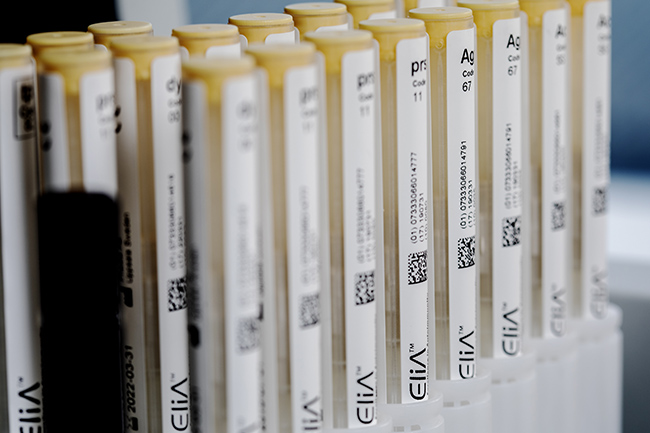Your partner for understanding polyautoimmunity and diagnostic intervention
What is polyautoimmunity?
Polyautoimmunity describes the presence of more than one autoimmune disease in a single patient.1 About 25% of patients with one autoimmune disease are likely to develop additional ones.2 Early recognition of autoimmunity symptoms and comprehensive autoantibody diagnostic tests are crucial for patients to receive timely answers and symptom relief.3 We’re by your side with EliA™ autoimmune diagnostics.
Laboratories play a critical role in identifying polyautoimmunity
Is your lab ready for the rise in autoimmune diseases?
Read our white paper to discover what your lab should know about the increase of autoimmune diseases, the emergence and prevalence of polyautoimmunity and how to support healthcare providers in their diagnosis with appropriate test menu options.

Guidance-Webinar-Summary-BMKT001447-EN-WW1732570018-Thumbnail.jpg)
Help healthcare providers choose the right tests for the right symptoms for patients with suspected polyautoimmunity
Discover what polyautoimmunity is, its prevalence, why early intervention is critical for a patient’s quality of life and the role clinical laboratories play in time to diagnosis.
Support healthcare providers in reducing the time to diagnose autoimmune diseases
These quotes, inspired by real patients and clinicians, highlight why accurate, timely diagnosis is important.
“I was told…that because I worked a lot that I brought this onto myself through stress… I gave up expressing how bad I felt and replaced it with the lie everyone loves so much: ‘I’m fine.’”
— From a 29-year-old patient whose celiac disease took two decades to diagnose.4
"...it takes...a patient seeing four doctors over the course of four years to be diagnosed and treated for an autoimmune condition, with many labeled as chronic complainers."
— A clinician’s observations about autoimmunity diagnosis.4
“The [message] that probably did the most detriment to me as a human was, ‘but you look fine.’ Because of that sentence… I would push through [and] completely stopped listening to my body. … I would tend to overexert myself to the point of exhaustion of illness… trying to prove to everyone that I can do it.”
— 27-year-old patient whose rheumatoid and psoriatic arthritis took a decade to diagnose.4
EliA autoimmune diagnostics
Helping labs optimize patient care without sacrificing workflow efficiency
EliA™ autoimmune test results are trusted globally by healthcare providers and clinical laboratories. The EliA™ portfolio includes more than 50 clinically relevant tests to aid in the diagnosis of autoimmune diseases, with optimized balance of specificity and sensitivity.

Give the full picture on polyautoimmunity
Patients count on healthcare providers to get answers about autoimmune disease symptoms to find relief. Discover what laboratories need to know about autoimmune diseases, polyautoimmunity and how to give healthcare providers access to an appropriate autoimmune test menu.
Celiac disease is often one of the autoimmune diseases present in those with polyautoimmunity.5
Why are general practitioners critical to patients who may have polyautoimmunity?
Polyautoimmunity is not just a clinical curiosity; it is a significant aspect of patient care that demands attention.6
Prompt and accurate diagnosis with appropriate treatment can improve patient outcomes and prevent significant morbidity and irreversible damage to the body.3,7
As the first point of contact, general practitioners play a pivotal role in early identification and in accurate and timely referral to secondary care.3

The role general practitioners play in identifying and managing polyautoimmunity
Recognize symptom overlap, create early intervention opportunities and reduce time to diagnosis.
Stay current with polyautoimmunity on our ImmunoSpotlight blog
Your partner in autoimmunity diagnostics.
Discover how general practitioners can enhance outcomes for polyautoimmunity through better patient management.
Explore this patient case study to demonstrate the importance of early GP intervention and comprehensive autoimmune testing.
Streamline your practice with a variety of autoimmune diagnostics
Whether you’re a healthcare provider or a laboratorian, Thermo Fisher Scientific offers valuable resources geared toward your specific needs. Need a fuller picture on testing for polyautoimmunity?
- Anaya JM. The diagnosis and clinical significance of polyautoimmunity. Autoimmun Rev. 2014;13(4):423-426.
- Samuels H, et al. Autoimmune disease classification based on PubMed text mining. J Clin Med. 2022;11(15):4345.
- Urruticoechea-Arana A, et al. Development of an app for referring systemic autoimmune diseases. Reumatol Clin. 2020;16(5):373-377.
- Gunning JN. ‘But you don’t look sick’: Memorable messages of emerging adulthood autoimmune disease. J Soc Pers Relat. 2023;40(6):2008-2030.
- Zingone F, et al. Celiac disease-related conditions: Who to test? Gastroenterology. 2024;167(1):64-78.
- Tripathi P, et al. The Kaleidoscope of Polyautoimmunity: An Odyssey of Diagnostic Dilemmas. Cureus. 2024;16(4):e57799.
- Botello A, et al. Prevalence of latent and overt polyautoimmunity in autoimmune thyroid disease: A systematic review and meta-analysis. Clin Endocrinol (Oxf). 2020;93:375-389.



